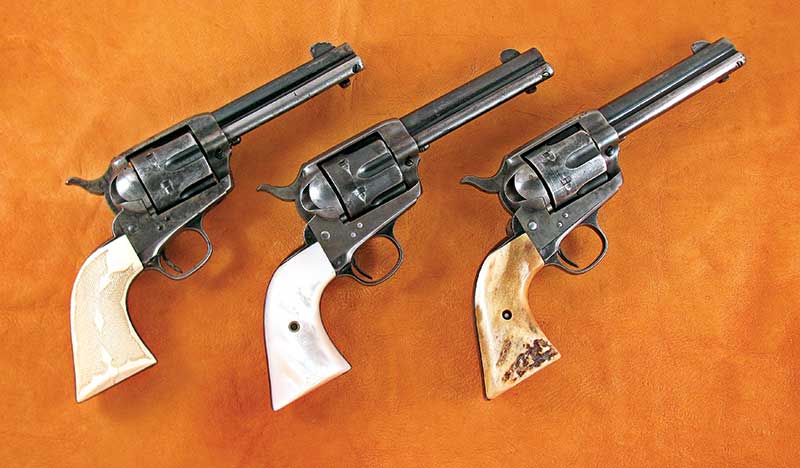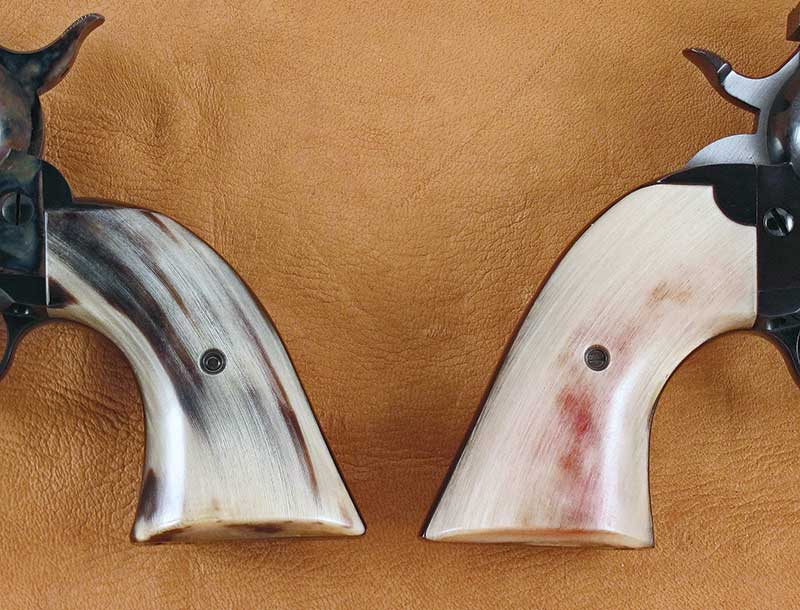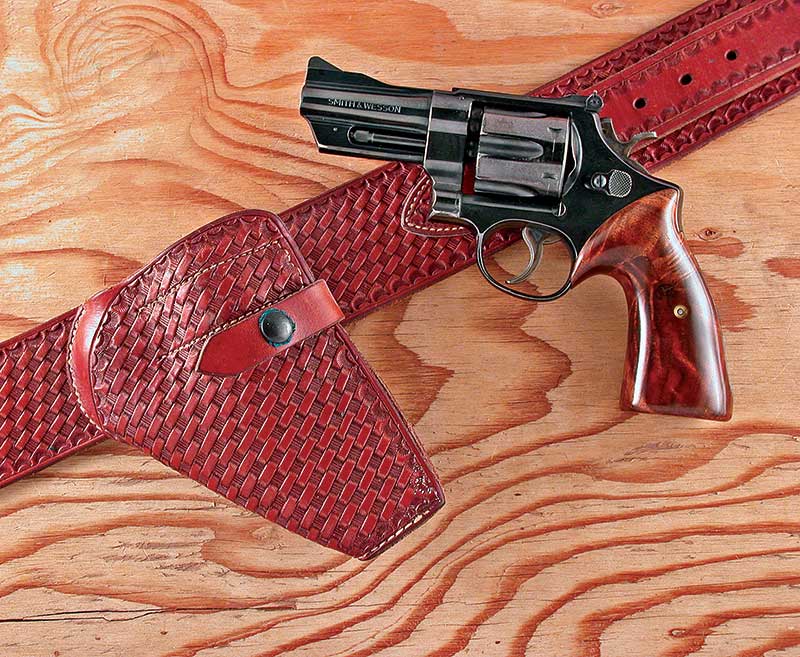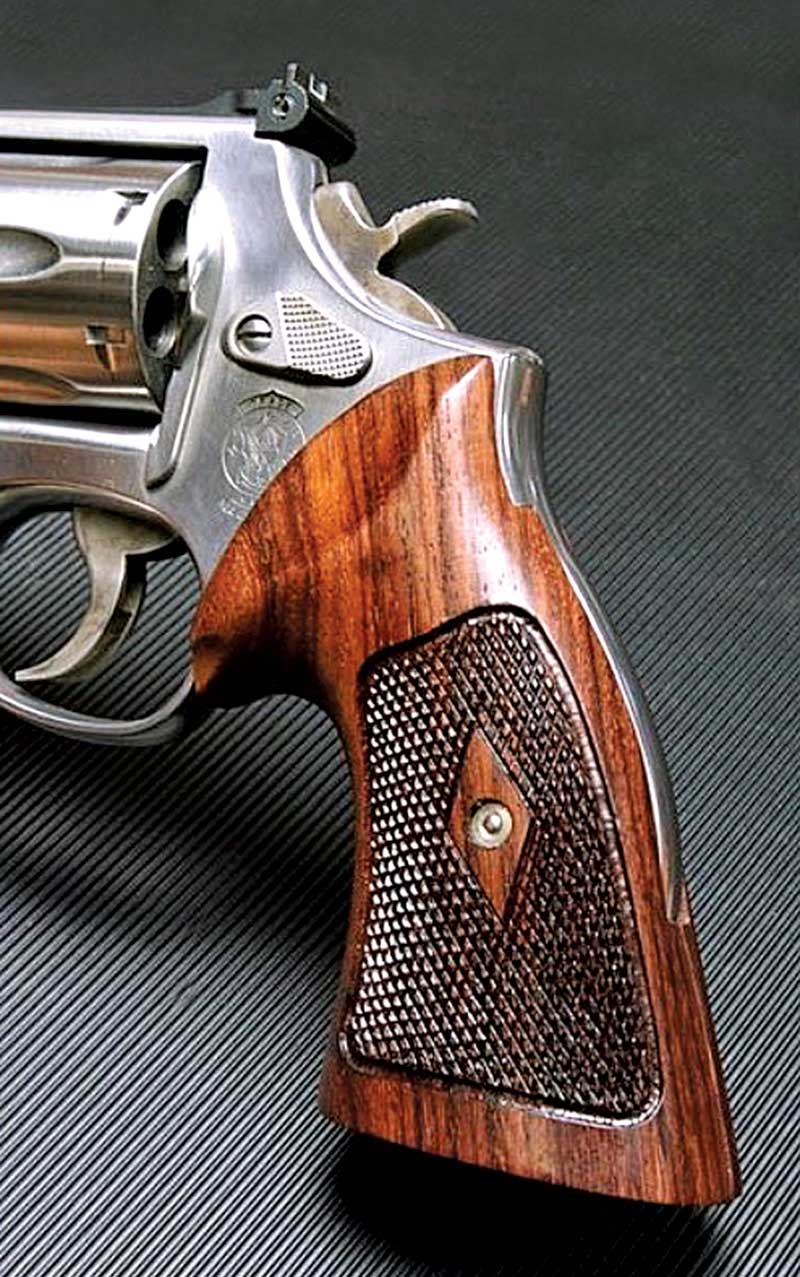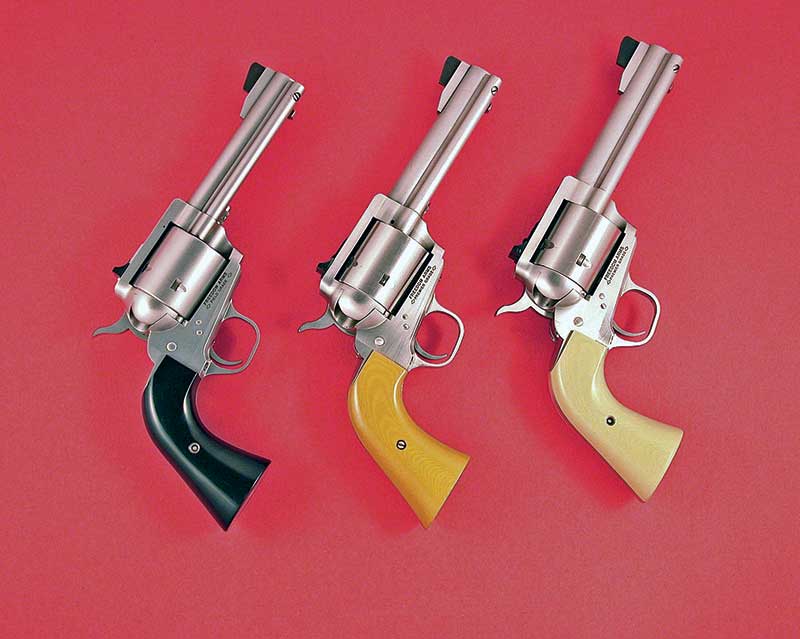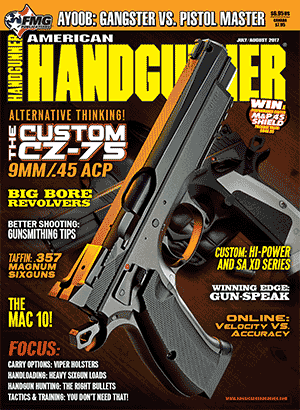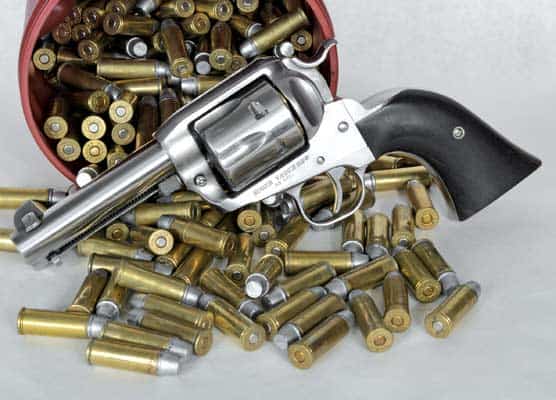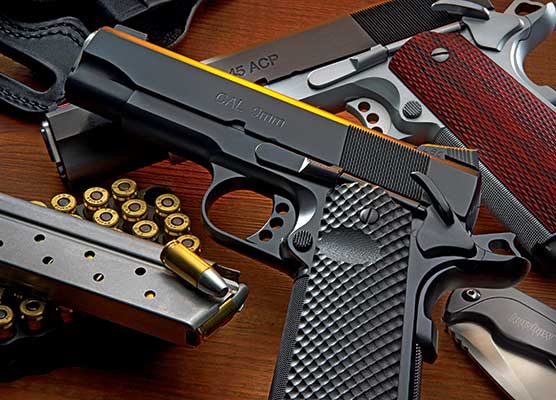Selecting & Caring For Sixgun Stocks
Handgun grips can be crafted from a myriad of materials such as ivory, ram’s horn, stag, plain or fancy woods and a whole gamut of synthetics from micarta to various polymers, even plastics. The selection of material is normally governed by the purse and/or purpose. If money is not an issue, ivory or ram’s horn can easily be chosen. If strength and durability is the number one factor, then the synthetics come into play. For my personal use, sixguns are equipped with ivory, ram’s horn, stag, fancy walnut, exotic woods, both ivory and black micarta and ivory polymers. I am very protective of those wearing the ivory and ram’s horn stocks, normally known as Bar-B-Q Guns, while the micartas or wood mostly get the nod for hunting sixguns.
Take a great sixgun from Colt, or Freedom Arms, or Ruger, or Smith & Wesson, or USFA, add great stocks, and you’ve the recipe for a lifetime of enjoyment. In the early days of both cap-n-ball and cartridge firing sixguns, you could order fancy stocks as a matter of routine, with Colt offering ivory and pearl grips for a modest increase in the price of their sixguns. One still encounters some of these old sixguns with their beautiful custom stocks still intact.
Sixguns are often found that were heavily used, with hardly any finish left but still having stocks of ivory or pearl in excellent shape. These materials are not quite as fragile as some would have us believe; after all, look at what an elephant does with his “ivories”! For a long time my look at pearl was jaded by the words of General George Patton. When he was asked about his pearl-handled revolvers by a reporter he responded, “Only a New Orleans pimp would carry a pearl-handled revolver!” But a look at famous sixguns used by several Southwestern lawmen, including Tom Threepersons, shows they preferred pearl as their grip material. Old Tom was every bit as tough as Patton and I doubt Patton would have called him a pimp or anything else.
Dr. Grip Maker?
Today if you’re looking for special grips, a custom stock maker is the answer. Skeeter used to say his holster maker was as important to him as his doctor. Well, my grip makers are as important to me as my doctors; one group keeps me shooting, the other keeps me alive. It’s a rare sixgun that does not have the stocks replaced when it comes into my hands, and the stocks on double-action sixguns are especially offensive.
Single-Action grips used to be much better, however too many of them are flared incorrectly today, at least for my hands, as they are too large and sharp at the bottom and too thin at the top. Some notable exceptions are Ruger’s Bisley grip, Freedom Arms Model 83 and Model 97 stocks. Most double-action sixguns today at least have functional rubber grips even if they do nothing to stir one’s soul, aesthetically speaking.
A pair of custom stocks not only allows better control of your sixgun, they also dress up a great sixgun and may say something about the personality of the user. Stocks of ivory or ram’s horn tell you the sixgunner is willing to spend as much, or more, for his stocks than he did for the gun, just to have the best possible material for grips now available.
After ram’s horn and ivory we find any number of exotic woods. I find a dark colored fancy walnut especially attractive, however, there are also other materials such as rosewood, birdseye and curly maple. Truly exotic types such as wenge, pau ferro, bloodwood and kingwood, are all very attractive too. Maple especially looks great on any sixgun be it of blue steel, stainless or nickel finish.
One of the best looking materials available for sixguns is staghorn. Normally stag is very rough and unsuitable for any sixgun having any appreciable recoil. However, when it’s thinned down and most of the roughness removed, it takes on the appearance of aged bone and becomes smooth to the sixgunner’s hand.
A very tough material for hard use is white or black micarta, a synthetic material from the electronics industry. It makes great sixgun grips. A good grade of ivory micarta soon takes on the appearance of aged ivory, while black micarta is my favorite on stainless steel hunting sixguns from Freedom Arms. When hunting or simply roaming off the beaten path, a long jacket will go a long way in protecting custom grips, and custom leather as well, from not only the elements but also banging against brush and trees.
BearHug
The number one request I get for grip information concerns the grips formerly offered by BearHug Grips. Deacon Deason of BearHug marketed the double action grips known as Skeeter Skelton Style that were especially fancied by users of Smith & Wesson sixguns. The late Skeeter patterned his grips after a modified Walter Roper design. Roper was a well-known handgunner and experimenter prior to World War II. His book, Experiments of a Handgunner is available in reprint form from Wolfe Publishing.
Roper designed the stocks found on Smith & Wesson double actions from before World War II to about the late 1950’s. After that they were changed by S&W, becoming too blocky and too large for anyone with average hands. Skelton changed the Roper design slightly to conform to his hand and the result is the best grips ever devised for double action Smith & Wessons.
Today, Eagle Grips and Herrett’s Stocks both provide grips patterned after the original Roper design, and Roy Fishpaw, the Master Gripmaker, also offers stocks much like the Roper/Skelton style. BluMagnum has the BearHug patterns and now provides the same basic grips too.
There are enough sixgunners interested in personalizing their sixguns with special stocks to keep several grip makers very busy. Some need grips to improve the handling of their sixguns; others simply want to dress that special revolver up a mite. In addition to the premium materials mentioned, a new material has recently been offered and that is bone. Grips made from bone, I believe they use either shoulder bone or thigh bone, of the giraffe and American bison, are exceptionally beautiful. The former is an almost translucent straw color, while the latter has beautiful blue and gray grain patterns.
No Objectivity
Most of us are not very objective when it comes to guns, women, cars, or dogs. Each of us is controlled to a great extent in all of these areas by our senses and past experiences. Personal taste in material is a large factor when choosing grips, however another very important reason is acquiring a better fit, both hand-to-grip and grip-to-grip frame. With some grips the shape or checkering adds greatly to security of handling when shooting. Grips are very personal and should have great aesthetic appeal to the eye and emotions, feel good to the hand and help with security and/or felt recoil. If they accomplish all three, so much the better.
Most sixgunners call them grips, however Steve Herrett, founder of Herrett’s Stocks, called them stocks as does his son Rod. I mostly use the two terms interchangeably, however with Herrett’s I try to always call them stocks. That first pair of Herrett’s Trooper stocks I ordered from them, fully checkered, enclosing the backstrap, and made to my hand pattern — cost all of $12. That amount of money won’t buy much anymore, however Herrett’s stocks are still made the way they were 60 years ago with attention paid to quality and fitting.
Quality custom stocks, perfectly fitted and shaped and of exotic material are not cheap. Today the cost of a pair of legal ivory grips would have enabled one 60 years ago to purchase a .357 and .44 Magnum Ruger Flat-Top, the Smith & Wesson .44 Magnum, and a Colt Single Action Army and all of them fitted with ivory stocks. With the money invested it’s prudent to take special care of custom stocks. For years I’ve been using Johnson’s Baby Oil on ivory grips and paste wax on wooden stocks. I recently had a conversation with the Master Gripmaker himself, Roy Fishpaw, and he shared his formulas for caring for stocks of various materials.
Care And Feeding
He said it was impossible to prevent all oils and solvents from running under and inside the grip area, however limiting it as much as possible is a good idea. This applies to all stock materials, and a cloth wrapped around the grip during cleaning would help. Here are Roy’s recommendations for different materials, and applies to the grips he makes, but can also be used as a guide for other makers’ work too.
“The finish I apply to the wood is a rubbed oil finish. The finish is more in the wood than on the wood,” explained Roy. “A periodic coat of quality furniture paste wax is fine. I use Mylands Traditional Wax, which is available from some of the better woodworking supply stores such as Woodcraft. All of the wood offered is sourced from suppliers who state the wood has been perfectly dried. The wood is cut at my shop to usable size and re-sawed. It’s allowed to sit six months or more. All care is taken to provide wood that will ‘stay put.’ That said, it’s not really possible to guarantee wood will never move. The beautiful, fancy grain that is most desired is often the most unstable because it comes from the part of the tree that is binding large limbs to the trunk, or supporting the entire tree at the base.
“Dall Sheep and Musk Ox horn is easy and there’s not much to do here except apply a coat of Mylands, or other quality furniture paste wax when you want to. Polished horn can show fingerprints after handling and wax will take care of that,” cautioned Roy. “It’s good to try to avoid major temperature extremes, mostly heat. Leaving a horn grip in a vehicle during summer will be a good way to see if you can get it to ‘move.’ Remember the natural sheep horn not only grows in a circle, it also twists as it does and likes to remember that!
“After final polishing in my shop, ivory gets a coat of mineral oil rubbed on and wiped off. A coat of mineral oil a couple of times a year is a good idea if you are in a dry climate. After a few years you can switch to a coat of wax when desired. For those who are not in a dry climate, you can apply the Mylands wax as desired. At least a couple of times a year would be good. Ivory does not like temperature extremes. It can crack if it gets too hot or too cold or changes temperature too quickly, so keep an eye on that.”
There are a host of makers out there, doing custom and “factory” grips so you’re sure to find what you like. Custom stocks/grips are as much of an investment as a good sixgun. It pays to take good care of them both.

